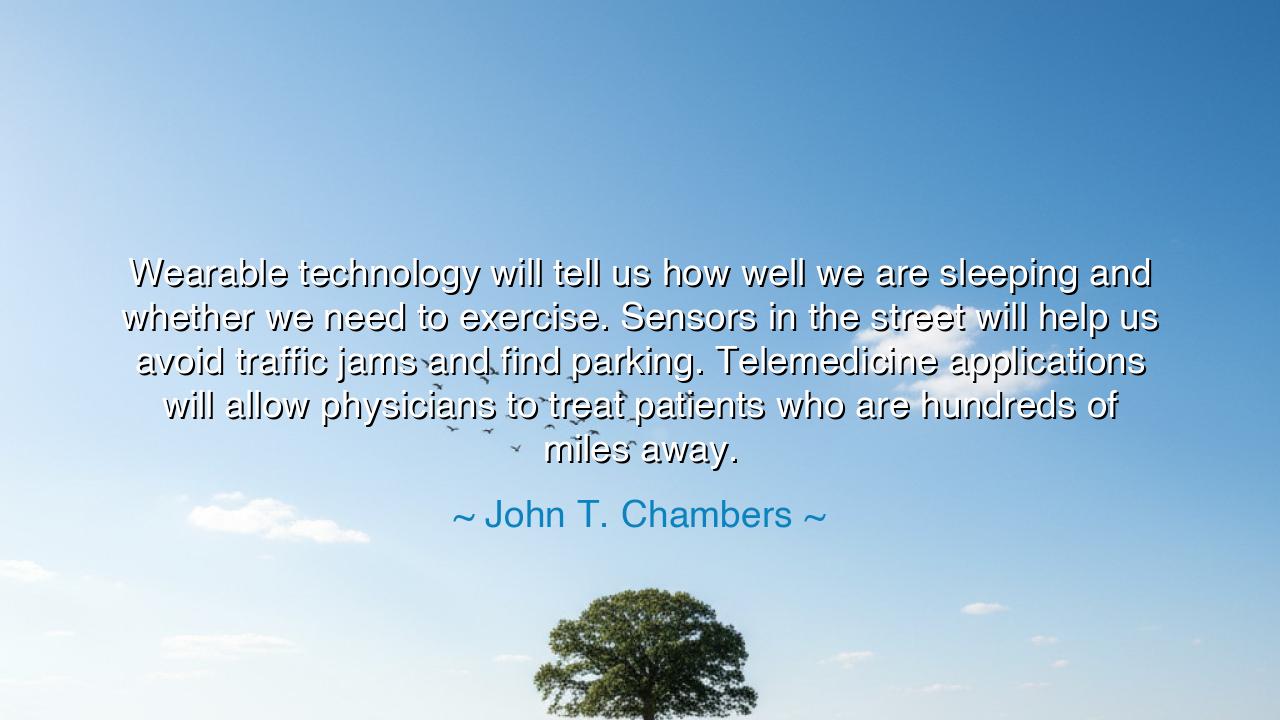
Wearable technology will tell us how well we are sleeping and
Wearable technology will tell us how well we are sleeping and whether we need to exercise. Sensors in the street will help us avoid traffic jams and find parking. Telemedicine applications will allow physicians to treat patients who are hundreds of miles away.






The words of John T. Chambers—“Wearable technology will tell us how well we are sleeping and whether we need to exercise. Sensors in the street will help us avoid traffic jams and find parking. Telemedicine applications will allow physicians to treat patients who are hundreds of miles away”—speak with the vision of one who has looked beyond the present and glimpsed the coming shape of human life. In these words there is no mere fascination with machines, but a recognition that technology is becoming woven into the very fabric of daily existence. Where once tools served only in moments of need, now they live beside us, upon us, even within our cities, guiding us toward healthier bodies, smoother journeys, and greater access to care.
The origin of this vision lies in the rise of the Internet of Things, that vast and invisible web where devices, sensors, and networks communicate ceaselessly to serve humanity. Chambers, as a leader in the digital world, foresaw that the power of connectivity would not remain in computers alone, but would stretch into every corner of our lives. The wearable device upon the wrist becomes a physician whispering advice. The sensor in the street becomes a silent guide, directing us away from congestion. The telemedicine application becomes a bridge of mercy, carrying healing across hundreds of miles. His words remind us that we are entering an age where the boundaries between human need and technological response grow ever thinner.
Consider the example of rural villages where once the sick would perish because the nearest doctor was days away. Today, with telemedicine, a child in a remote corner of India or Africa can be seen by a physician in a great city, diagnoses shared through screens, prescriptions delivered with precision. What was once a tragedy of distance has become a triumph of connection. This is Chambers’s prophecy alive in the present: technology as the redeemer of isolation, the conqueror of distance, the healer of wounds once untended.
In like manner, cities have long suffered under the weight of traffic, a modern plague that steals time, burdens the body with stress, and chokes the air with fumes. Yet through intelligent sensors and connected systems, the very streets themselves now learn to guide us—warning of congestion, opening paths, finding spaces where once we circled in frustration. This is no idle comfort but a revolution of order: time returned to families, fuel spared, and the city itself breathing more freely. Here we see how technology, when guided by wisdom, becomes not an enemy but an ally of human flourishing.
And what of wearable technology, those small companions that watch the rhythms of our hearts and the cycles of our sleep? They remind us of what the ancients already knew: that to live well, one must know oneself. But where sages once counseled reflection, today’s tools provide measurement, showing us when we must rest, when we must move, when the body is drifting toward danger. It is the union of ancient wisdom with modern precision—know thyself, now translated into numbers and alerts that guard our health.
Yet there is also a warning hidden in Chambers’s vision. For though these tools expand our possibilities, they also bind us more closely to the digital net. To depend on them without reflection is to risk surrendering our freedom to convenience, our privacy to data, our humanity to machinery. Thus the challenge of our generation is not merely to use these tools, but to use them wisely, with restraint, ensuring that they remain servants of human dignity and not masters of our lives.
The lesson for us is this: welcome technology not with fear, nor with blind adoration, but with discernment. Embrace the wearable that helps you rest and rise in health, but do not let it enslave your mind with constant measurement. Use the street sensors that save you time, but remember to walk sometimes with no destination, free from guidance. Accept telemedicine as a blessing to the distant and the poor, but guard the sacred bond between patient and healer, lest the screen replace the human touch entirely.
So let us carry forward Chambers’s words as both vision and charge: technology is becoming the fabric of life, broadening our strength, lightening our burdens, and extending our reach across time and space. But it is we who must shape its purpose. If we walk with wisdom, then the digital age will not strip us of humanity but will magnify it, making us stronger, freer, and more connected than ever before. And in this balance lies the true destiny of mankind: to wield tools not as chains, but as wings.






AAdministratorAdministrator
Welcome, honored guests. Please leave a comment, we will respond soon